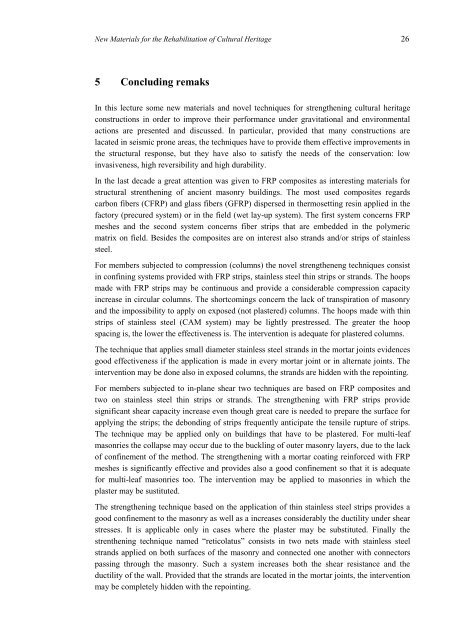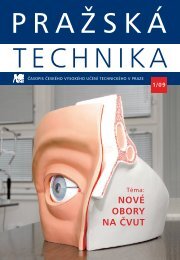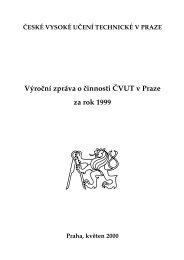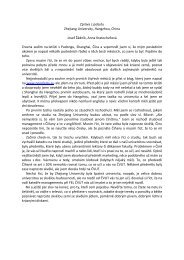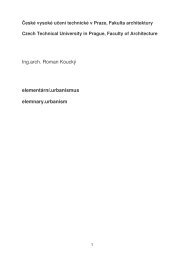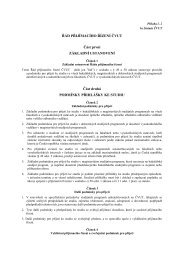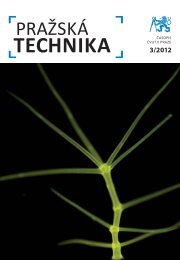New Materials for the Rehabilitation of Cultural Heritage - Czech ...
New Materials for the Rehabilitation of Cultural Heritage - Czech ...
New Materials for the Rehabilitation of Cultural Heritage - Czech ...
Create successful ePaper yourself
Turn your PDF publications into a flip-book with our unique Google optimized e-Paper software.
<strong>New</strong> <strong>Materials</strong> <strong>for</strong> <strong>the</strong> <strong>Rehabilitation</strong> <strong>of</strong> <strong>Cultural</strong> <strong>Heritage</strong> 26<br />
5 Concluding remaks<br />
In this lecture some new materials and novel techniques <strong>for</strong> streng<strong>the</strong>ning cultural heritage<br />
constructions in order to improve <strong>the</strong>ir per<strong>for</strong>mance under gravitational and environmental<br />
actions are presented and discussed. In particular, provided that many constructions are<br />
lacated in seismic prone areas, <strong>the</strong> techniques have to provide <strong>the</strong>m effective improvements in<br />
<strong>the</strong> structural response, but <strong>the</strong>y have also to satisfy <strong>the</strong> needs <strong>of</strong> <strong>the</strong> conservation: low<br />
invasiveness, high reversibility and high durability.<br />
In <strong>the</strong> last decade a great attention was given to FRP composites as interesting materials <strong>for</strong><br />
structural stren<strong>the</strong>ning <strong>of</strong> ancient masonry buildings. The most used composites regards<br />
carbon fibers (CFRP) and glass fibers (GFRP) dispersed in <strong>the</strong>rmosetting resin applied in <strong>the</strong><br />
factory (precured system) or in <strong>the</strong> field (wet lay-up system). The first system concerns FRP<br />
meshes and <strong>the</strong> second system concerns fiber strips that are embedded in <strong>the</strong> polymeric<br />
matrix on field. Besides <strong>the</strong> composites are on interest also strands and/or strips <strong>of</strong> stainless<br />
steel.<br />
For members subjected to compression (columns) <strong>the</strong> novel streng<strong>the</strong>neng techniques consist<br />
in confining systems provided with FRP strips, stainless steel thin strips or strands. The hoops<br />
made with FRP strips may be continuous and provide a considerable compression capacity<br />
increase in circular columns. The shortcomings concern <strong>the</strong> lack <strong>of</strong> transpiration <strong>of</strong> masonry<br />
and <strong>the</strong> impossibility to apply on exposed (not plastered) columns. The hoops made with thin<br />
strips <strong>of</strong> stainless steel (CAM system) may be lightly prestressed. The greater <strong>the</strong> hoop<br />
spacing is, <strong>the</strong> lower <strong>the</strong> effectiveness is. The intervention is adequate <strong>for</strong> plastered columns.<br />
The technique that applies small diameter stainless steel strands in <strong>the</strong> mortar joints evidences<br />
good effectiveness if <strong>the</strong> application is made in every mortar joint or in alternate joints. The<br />
intervention may be done also in exposed columns, <strong>the</strong> strands are hidden with <strong>the</strong> repointing.<br />
For members subjected to in-plane shear two techniques are based on FRP composites and<br />
two on stainless steel thin strips or strands. The streng<strong>the</strong>ning with FRP strips provide<br />
significant shear capacity increase even though great care is needed to prepare <strong>the</strong> surface <strong>for</strong><br />
applying <strong>the</strong> strips; <strong>the</strong> debonding <strong>of</strong> strips frequently anticipate <strong>the</strong> tensile rupture <strong>of</strong> strips.<br />
The technique may be applied only on buildings that have to be plastered. For multi-leaf<br />
masonries <strong>the</strong> collapse may occur due to <strong>the</strong> buckling <strong>of</strong> outer masonry layers, due to <strong>the</strong> lack<br />
<strong>of</strong> confinement <strong>of</strong> <strong>the</strong> method. The streng<strong>the</strong>ning with a mortar coating rein<strong>for</strong>ced with FRP<br />
meshes is significantly effective and provides also a good confinement so that it is adequate<br />
<strong>for</strong> multi-leaf masonries too. The intervention may be applied to masonries in which <strong>the</strong><br />
plaster may be sustituted.<br />
The streng<strong>the</strong>ning technique based on <strong>the</strong> application <strong>of</strong> thin stainless steel strips provides a<br />
good confinement to <strong>the</strong> masonry as well as a increases considerably <strong>the</strong> ductility under shear<br />
stresses. It is applicable only in cases where <strong>the</strong> plaster may be substituted. Finally <strong>the</strong><br />
stren<strong>the</strong>ning technique named “reticolatus” consists in two nets made with stainles steel<br />
strands applied on both surfaces <strong>of</strong> <strong>the</strong> masonry and connected one ano<strong>the</strong>r with connectors<br />
passing through <strong>the</strong> masonry. Such a system increases both <strong>the</strong> shear resistance and <strong>the</strong><br />
ductility <strong>of</strong> <strong>the</strong> wall. Provided that <strong>the</strong> strands are located in <strong>the</strong> mortar joints, <strong>the</strong> intervention<br />
may be completely hidden with <strong>the</strong> repointing.


